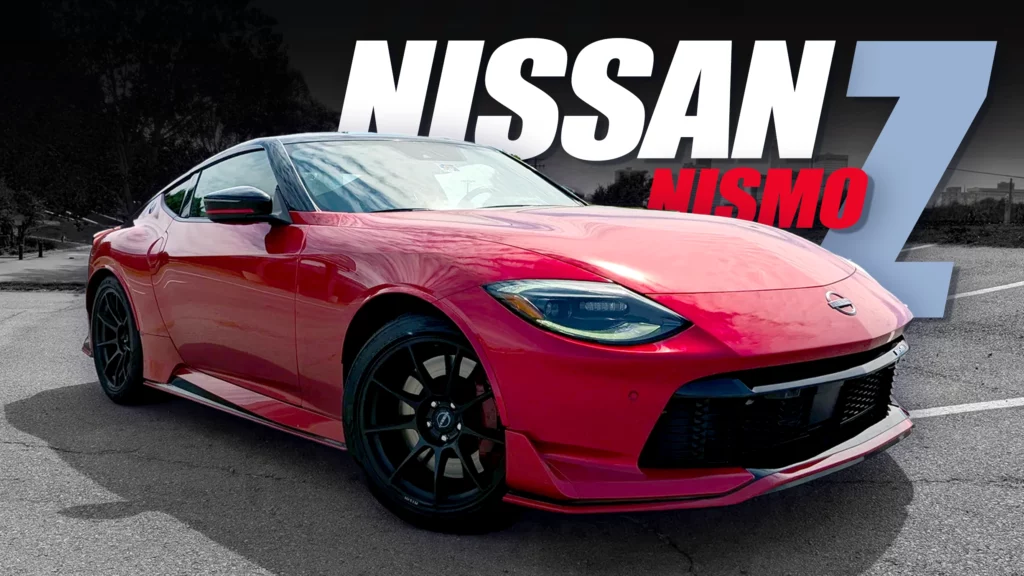Fun. That’s the one word that best describes the Nissan Z Nismo. Today’s sports car segment is crowded with models that prioritize everything but fun. They chase faster lap times, higher cornering G-forces, quicker 0-60 sprints, and colossal downforce stats.
The Nissan Z Nismo wants to be fast too, but it’s not as quick as some of its competitors. What’s perhaps most important though is that it doesn’t need to be. In fact, it might be better off because it’s not as speedy.
After driving what will soon be Nissan’s only in-production sports car for a week, I learned a lot. The latest Z revealed its secrets, showed its limitations, and kept a smile on my face the entire time. We’ve tested other Z trims in the past, but today, let’s talk about this top-trim model that makes every day feel like a track day.
Quick Facts
Under The Skin
Nissan brought the normal Z to market with a twin-turbocharged V6 that makes 400 horsepower (298 kW) and 350 lb-ft (474 Nm) of torque. Compared to the rest of its segment, those figures are quite stout. The normal Z also happens to cost south of $50,000 in its base form.
This Z though, the Nismo, will set buyers back some $66,890 or in our case, with options, $68,690. For that extra cash, you get unique 19-inch wheels, new exterior styling bits for additional downforce, and the option of several very pretty colors. Our test car arrived in Passion Red TriCoat, which is honestly how I personally would order one. It looked great everywhere.
Review: 2024 Hyundai i30 N Sedan Perfects Price-Performance Ratio
More importantly, though, the Z Nismo boasts serious performance enhancements over the standard Z. New stabilizer bars, stiffer springs, and retuned dampers improve ride control. Bushings throughout the car are also stiffer, which makes it easier for the driver to understand what the car is doing.
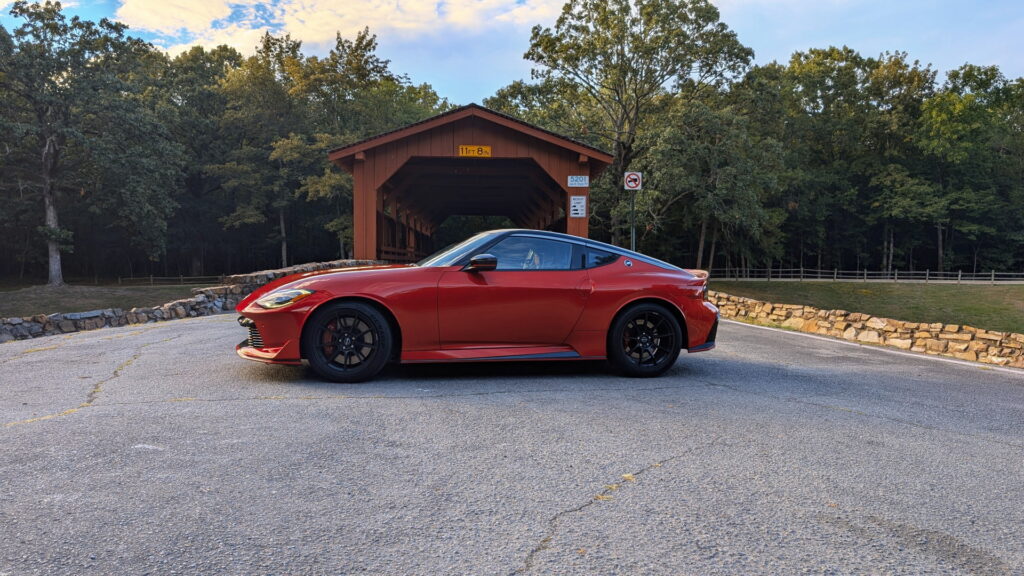
Nissan didn’t stop there though. It also added an engine oil cooler and revised the electronic wastegate controllers on the turbos. As a result, this car develops 420 horsepower ( kW) and 384 lb-ft ( Nm) of torque. Those are welcome, albeit not earth-shattering, improvements in the power department.
Finally, Nissan limits the Z Nismo to an automatic transmission only. While this might upset some purists who’d prefer the option of a manual on a sports car, it’s not that surprising. For example, the Chevrolet Corvette also can’t be had with a stick. The Toyota Supra wasn’t available with one at launch either. Again, on paper, this car sounds like Nissan’s track-day special compared to the normal Z or even the mid-tiered Z Performance. How do all of these choices stack up in the real world? We’ll get to it but let’s talk a little about the cabin first.
Interior
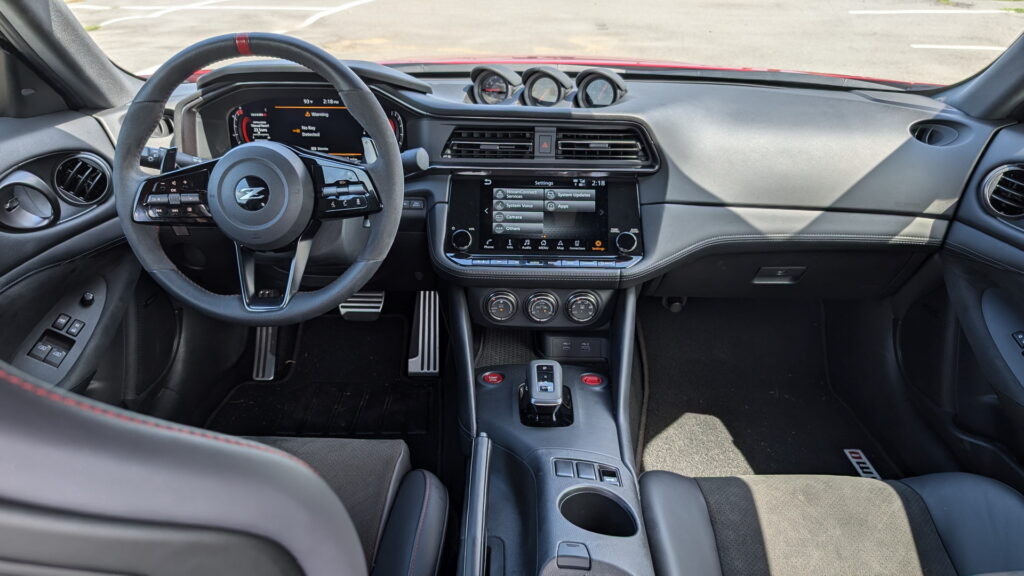
All new-generation Zs share chassis components with their predecessor, the 370Z. That said, anyone who has sat in the older car will recognize several aspects of the newer one. Frankly, it’s not a bad thing either as both cars are comfortable and provide a good driving position. As my colleague Brad Anderson found out in the normal Z though, taller drivers will need to slouch some. At 6 ‘6, I absolutely couldn’t sit up straight no matter how I positioned the seat.
Speaking of the seats, they’re comfortable no doubt and I really like how well bolstered they are. They hold you in place but also aren’t as hardcore and extreme as one might expect. Nissan found a great balance there and so maybe that’s why it chose them despite the frustrating controls on them.
Being that this is a track-focused car, the seat controls are all manual. There are four separate adjustments. Sliding forward and back, raising or lowering the front or rear of the seat cushion, and then positioning the angle of the backrest. The only easy adjustment is that of the sliding function. The other three are controlled with round or rotary-shaped dials.
The one furthest toward the rear of the seat is all but untouchable if the seat is pushed all the way back and so changing the backrest angle is basically impossible without getting out of the car to do it. If I was 5’6 it might be easier since the seat would be slid further up and the control dial would be slightly easier to access. Still, why do it this way? What was wrong with a simple lever? Is this why Recaro went bankrupt? I jest, but the reality with a real track day car is that one almost always accepts some compromises. The seats here feel like one of them. Excellent once they’re positioned right, but getting them there is a task.
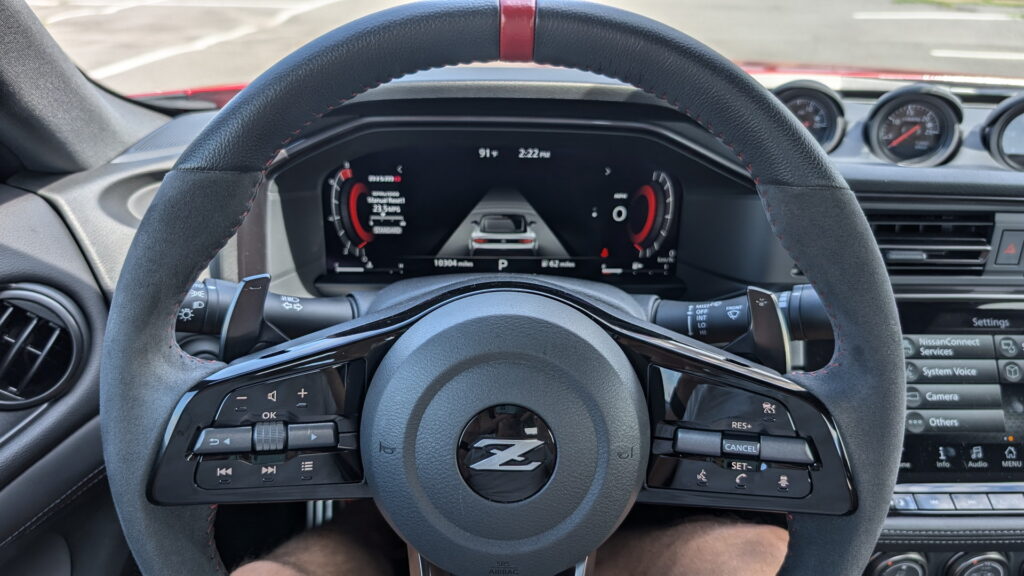
Once one is comfortably in the seat, the cabin is mostly underwhelming. Nothing really shouts out loud that this is a special car. The center console, the dash, and much of the door card surfaces feel cheap and a touch out of place in a car priced within a Honda Moto Compacto of $70,000. Again though, how many real track cars have super-posh interiors? It’s not about soft-touch surfaces and intricate ambient light shows. This car is meant to go fast.
That said, the controls are well-placed and intuitive to use. The infotainment system is unobtrusive, quick enough for everyday life, and doesn’t bury important functions. Physical HVAC controls sit beneath it and a real volume and tuner knob are welcome additions. I think the trio of gauges atop the dash is a great call back to this car’s purpose too. Nissan could’ve put another screen there but instead, we get real gauges, which are awesome.
Then there’s the big highlight of the cabin, the steering wheel. Decked out in Alcantara and leather, this piece of the car feels like a high-end chef’s knife. It’s versatile thanks to backlit buttons, the tactile experience is pleasing too, and the positive interaction from the switchgear, including the paddles, is a joy to work with. Read on to find out exactly what we mean.
Drive Impressions
Throw 1,000 horsepower at a car and it won’t mean much if you can’t comfortably and confidently control it. Give a driver exceptional feedback though and even low-horsepower cars can become icons (looking at you Mazda Miata). The Z Nismo takes everything good about the lower-trimmed versions and dials in the performance and driver feedback even more.
Simply put, the Z Nismo feels sharp even at slow speeds. The steering feedback is so natural and the body control makes driving it almost instinctive. Placing it on an apex or darting through traffic is an absolute breeze. Taking it onto public roads provides exactly the experience I was hoping for. Last year, I drove the new BMW M2 and that car felt great. I still believe that it’s an incredibly fun car but it’s more muted in retrospect.
The Nissan Z Nismo leans into the fun even more. It’s not as quick but it’s more playful and doesn’t take itself so seriously. It also happens to be around 200 pounds lighter than the BMW and it’s the kind of difference one can feel from the driver’s seat.
Carving corners feels natural and confidence-inspiring. 420 horsepower is nothing to sneeze at but in the Z Nismo, you feel like you have complete control at all times. This is one of the most balanced sports cars on sale right now. No doubt, the sticky Dunlop SP Sport MAXX GT600 tires lend to that.
When the Z showed up without Michelin or Pirelli tires I admit I balked a bit, but these Dunlops are well-suited to the car. They allow for slip and power sliding while also being very predictable. I don’t trust them in the wet the same way that I do a Pilot Sport though. In a straight line, the tires do an excellent job of grabbing dry pavement and rocketing the Z Nismo forward.
Review: The BMW M2 Is A Dinosaur That’s Heaps Of Fun To Drive
With the use of a Dragy GPS logger, we recorded a 4.46-second zero to sixty time on an unprepared surface. Calculating one foot of rollout, a typical way of measuring zero-to-sixty times, and that figure drops to just 4.20 seconds. On suitable roads, it pulls hard at even extra-legal speeds. We have no doubt about it being capable of eclipsing 155 mph (250 km/h) or more.
In everyday driving situations, the sharpness is ever-present but the ride, while firm, isn’t overly harsh. Having driven a Rallycross-bred Subaru for years, the Z felt far more comfortable. The damping is strong and helps the car to avoid excessive banging and crashing over bad road conditions. The cabin is relatively quiet and the exhaust is a nice reminder from time to time that you’re driving something akin to a Mako in a sea of overweight whales. On top of that, the brakes are strong, sharp, and easy to modulate. The car doesn’t get unsettled when you hit them hard either.
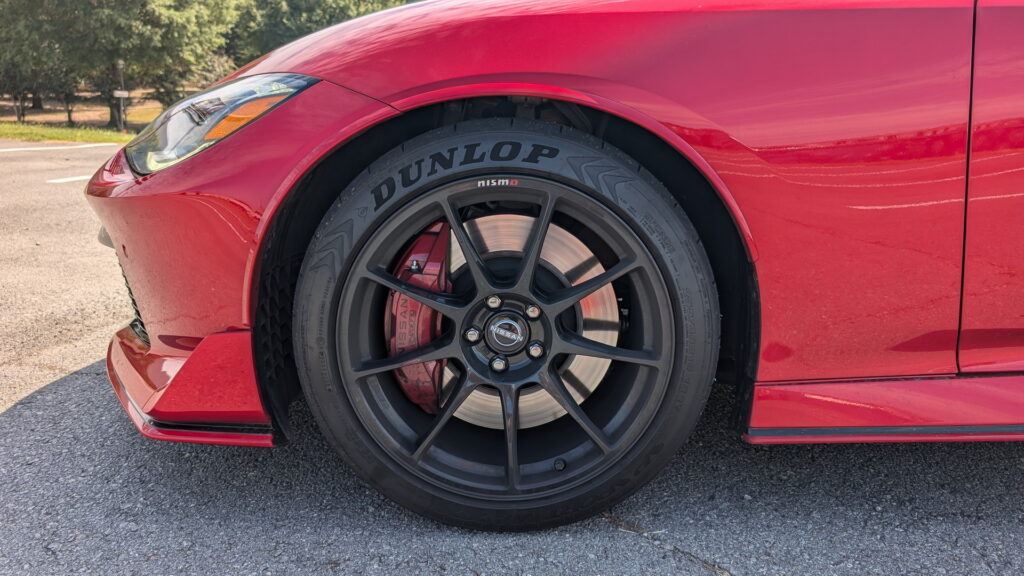
Finally, let’s talk about the gearbox. On its own, it’s actually fine. Though not a dual-clutch, it’ll swap cogs at a reasonable pace when called upon and in its most aggressive automatic setting (Sport+) it’s intuitive and good at determining what the driver wants. I’d still love to see just how much sharper this car would feel with a dual-clutch but here’s the kicker: I think the Z Nismo would benefit from a stick shift more.
This is a genuinely fun car to drive and I found myself looking for excuses to get out of the house, even if only for a few minutes, to enjoy it. My sincere belief is that it would be even more engaging with three pedals. Would it be as fast?
Maybe not, but unless Nissan has some wild trick up its sleeve, the Z isn’t about to go out and smash cars like the Toyota Supra at the race track. We’d say lean into making the Z Nismo even more engaging and fun. A manual gearbox would do that, so here’s hoping that Nissan will add this option in the future.
What else can you get for that money?
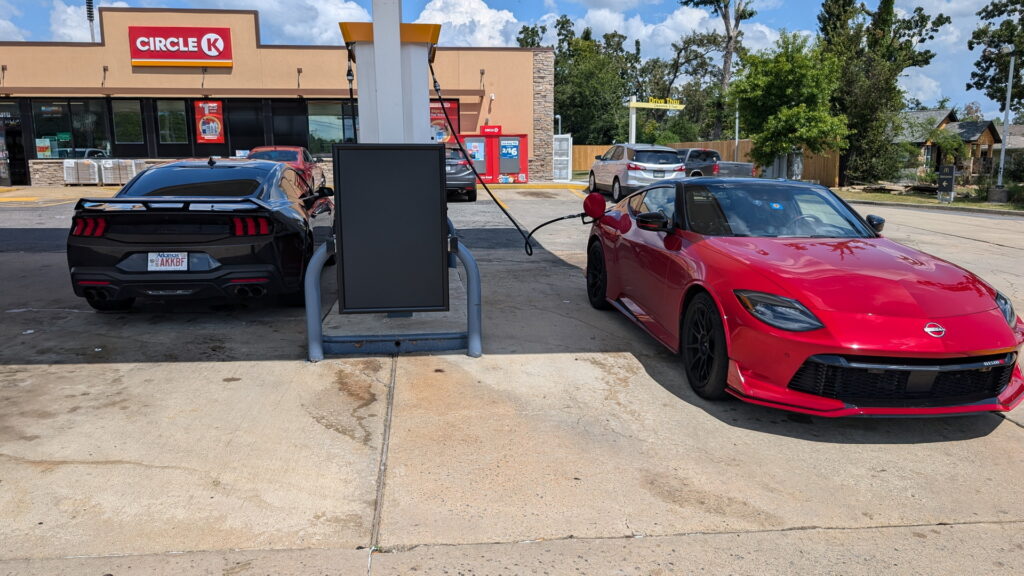
The Nissan Z Nismo goes to battle against a bunch of other excellent performance cars every day. On paper, it’s not often the winner though. Sure, it’s competitively priced against the Toyota Supra that starts at around $57,000, which is more than the mid-tiered Z Performance.
At the same time, our test car (including options) costs about the same as a base Chevrolet C8 Corvette, Porsche 718 Boxster, or 718 Cayman. Those cars all offer things like cabin accouterments, a mid-engine layout, and technology that the Z doesn’t. All but the Corvette can be had with a stick shift too.
Who then is the Z for? Nissan lovers for sure, but the demographic is bigger than that. Somewhat surprisingly, the Z and Supra are neck and neck in terms of sales through the first half of the year. Of course, neither holds a candle to cars like the Ford Mustang, Chevrolet Corvette, and BMW 2-Series when it comes to total sales.
Final Thoughts
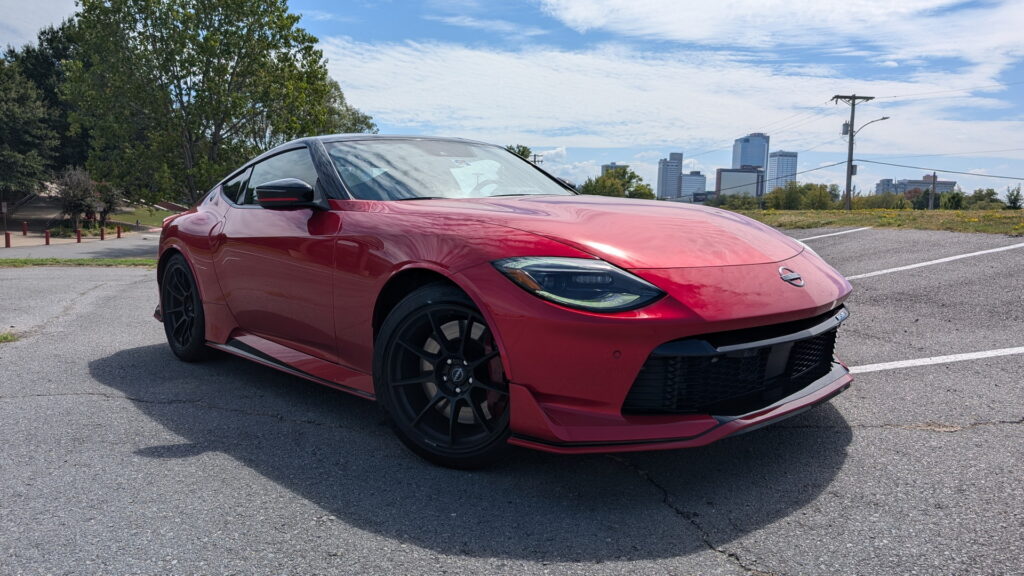
I kicked off this review by telling you that the Nissan Z Nismo makes every day a track day, so let me sum up why. This little sports car is full of compromises that keep it from being the fastest, the sharpest, or the most technologically advanced in its segment. The interior feels less special than it should. The lack of a manual gearbox is a bit of a letdown. The stiff suspension might be uncomfortable to some.
Still, these aspects of the Z Nismo are part of why it feels like every day is a track day. Track-day cars often come with several compromises in the name of performance and speed. Slipping into the Z while headed to the office, the store, or toward your favorite back road is a special experience despite any downfalls it might have and that’s because of how it feels to drive.
It turns everyday runs into joyful occasions full of fun, playfulness, and speed whenever you want it. It also reminds you that it’s not some quaffed 700-horsepower ego fluffer. To drive it regularly, a person needs to fit both physically and mentally. They need to enjoy a passionate drive more than they do having a seat massager and some fancy lighting. The reward is great, though, because for those of us that love a good track day, that’s every day in the Nissan Z Nismo.



